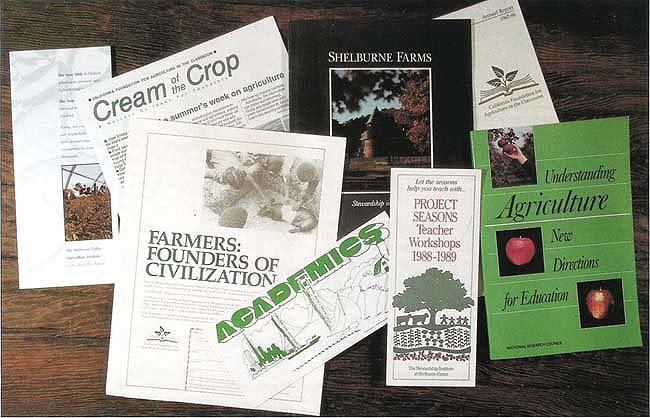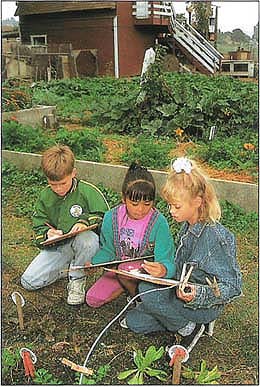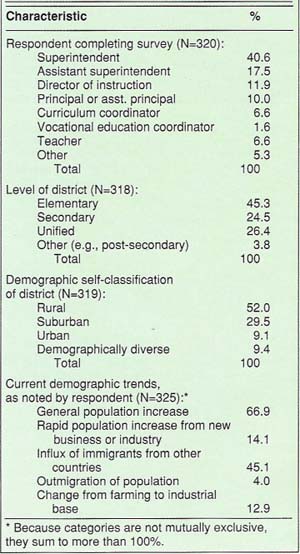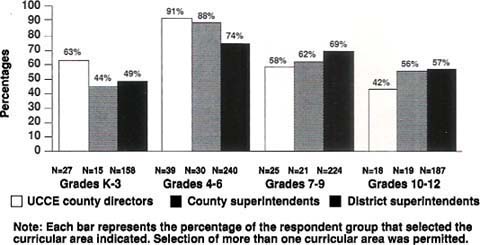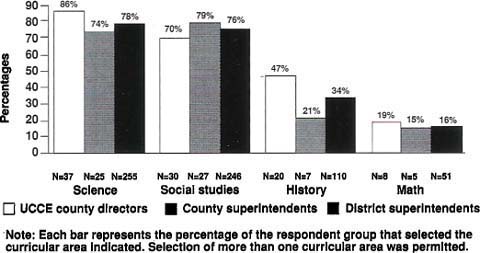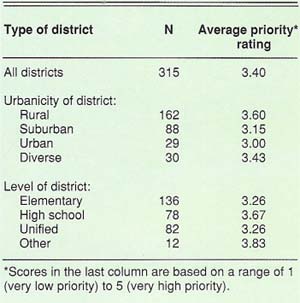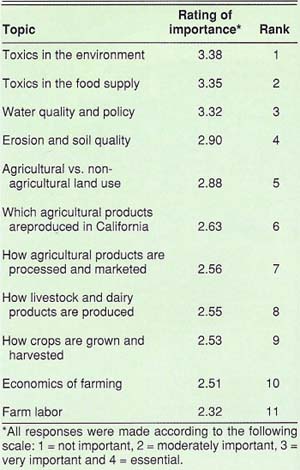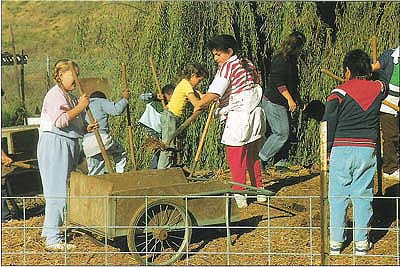All Issues
Toxics, food safety, water quality “most important”: How California educators and CE directors view “agricultural literacy” programs
Publication Information
California Agriculture 45(6):4-9.
Published November 01, 1991
PDF | Citation | Permissions
Abstract
Agricultural literacy programs —now underway in a few California schools — are designed to provide students with a fundamental understanding of how our agricultural system works, including its relationship to natural resources and the environment. In statewide surveys, public school administrators and CE county directors agreed such programs should be incorporated into science or social studies classes during late elementary and middle grades. District administrators identified the most important topics to be toxics in the environment, toxics in the food supply, and water quality and policy. Groups surveyed expressed differing opinions, however, about the plant Of teaching the topic in schools.
Full text
With increasing frequency and urgency, society is called upon to make decisions about critical agriculture-related issues such as food safety, land use, and water policy. In order to make informed decisions, the American public must have a basic understanding of agriculture and its role in our society and economy. Yet several recent reports have concluded that the public's knowledge of agriculture is inadequate. The most prominent of these was a 1988 National Research Council report commissioned by the U.S. Departments of Agriculture and Education, Understanding Agriculture: New Directions for Education. As a result, the concept of “agricultural literacy” has been receiving more attention among scientists and policymakers in both California and the nation.
Proponents of agricultural literacy agree that one of the primary avenues for promoting public understanding should be our schools. In clarifying the roles of school programs, the National Research Council drew an important distinction between two sets of educational objectives: Education “in” agriculture refers to programs that prepare students for agricultural careers. These programs focus on vocational skills and, by design, reach a relatively small percentage of students. In contrast, education “about” agriculture refers to programs that promote agricultural literacy among all students. These programs teach students agricultural information and skills they will need in order to participate as citizens in a democratic society. Content typically includes fundamental principles of food and fiber production, agricultural marketing, nutrition and diet, and other topics.
Nonformal (out-of-school, yet structured) channels for teaching about agriculture have existed for many years, primarily through Cooperative Extension 4-H programs. However, school-based programs are rare, and those that do exist are usually underfunded. One of the most popular school programs is “Ag in the Classroom,” instituted several years ago by the U.S. Department of Agriculture. Other programs exist in scattered areas, usually the result of local initiative (see sidebar). Nevertheless, the majority of the nation's children remain unexposed to programs and curriculum materials that address agricultural issues to any significant degree.
Recognition of the need for greater public understanding of agriculture is only the first step in the educational program development process. Broad questions remain about what the actual content and approach of agricultural literacy programs should be. To facilitate this early stage of planning, a UC Cooperative Extension (CE) research team conducted an inquiry into the state of agricultural literacy programs in California. One of our primary aims was to determine the views of administrators across the state on specific issues. Through contacts with educators and CE personnel, we also identified several highly regarded programs now in operation. We conducted site visits to seven of these to study their goals, philosophies, successes and problems.
Survey procedures
Three separate, critical populations were surveyed to determine their views on agricultural literacy education: county superintendents of education, CE county directors, and district superintendents of education. All populations received a two-page questionnaire, with the first two groups receiving an early version (survey 1) and the district superintendents receiving an expanded and revised version (survey 2). Both surveys began by defining agricultural literacy as a “basic understanding of where our country's food and fiber come from.” The surveys asked respondents to identify the grade levels in which, in their judgment, agricultural literacy education is most appropriate. Grade levels were grouped into the following blocks: kindergarten to grade 3, grades 4 to 6, grades 7 to 9, and grades 10 to 12. Both surveys also asked for respondents' opinions on which curricular areas are most appropriate for teaching agricultural literacy: social studies, history, language arts, mathematics, science, or as an independent curricular area. These two items, addressing appropriate grade levels and subject areas, permitted multiple responses. The surveys also asked respondents to identify ongoing educational programs in their counties.
The surveys differed in the item that reflected the overall significance of agricultural literacy. Survey 1 asked respondents to judge the importance of teaching agricultural literacy on a seven-point scale from “not important at all” to “extremely important.” In the revised survey 2, respondents were asked to rate the priority that should be given to teaching agricultural literacy in schools, on a five-point scale from “very low priority” to “very high priority.” This change in item wording was made to address more directly the willingness to devote actual class time to the topic. Survey 2 also included several new sections. To address the potential content of agricultural literacy programs, respondents were asked to rate the individual importance of teaching 11 possible subtopics (see table 3). Finally, survey 2 asked respondents to identify demographic trends in their districts such as population increases, growth of industries, and changing economic bases.
Survey 1 was mailed to all county public school superintendents and all UC Cooperative Extension (CE) county directors in May 1989. Follow-up telephone calls were made 2 weeks, 4 weeks and 6 weeks after the initial mailing, with a second copy of the survey sent to nonrespondents at 4 weeks. Survey 2 was sent in September 1989 to 600 randomly selected school district superintendents in California, which represents about half of the districts in the state. A follow-up mailing to nonrespondents, with a replacement questionnaire, was made in December. The cover letters for the county and district superintendent surveys explained that the questionnaire could be completed either by the superintendent or a designated associate.
The seven visits to program sites were conducted in the fall of 1989. These visits included tours of facilities and tape-recorded interviews with key personnel. Most programs selected for case study came to our attention from the county superintendent and county director responses to survey 1. Sites were selected to reflect a diversity of curricular approaches, educational strategies, program size, urbanicity, geographical location, range of educational strategy and program focus (see sidebar).
Results
Replies to survey 1 were received from 34 of the 58 county superintendents' offices, a response rate of 59%, and from 43 of the 54 CE county directors, a response rate of 80%. Replies to survey 2 were received from 326 district superintendents' offices, a response rate of 54%.
Most responding districts (45%) were elementary level, with about equal numbers of secondary (25%) and unified districts (26%) represented in the sample (table 1). Most responding districts classified themselves as rural (52%), with only a small number identifying themselves as urban (9%). Furthermore, 67% of the responding districts were experiencing a general population increase, with nearly half also indicating a substantial influx of immigrants from other countries (45%). In most cases (58%), the actual respondent to the questionnaire was the superintendent or assistant superintendent.
Overall, most district respondents rated agricultural literacy education as deserving moderately high priority, since the average rating of 3.40 is somewhat higher that the neutral middle point of 3.00 (table 2). This judgment varies according to type of district, with rural districts considering the topic more important than urban districts (3.60 vs. 3.00), and high school districts considering it more important than elementary districts (3.67 vs. 3.26).
Fig. 1. Appropriate grades for teaching agricultural literacy, as judged by three survey respondent groups.
The overall ratings of county superintendent offices and CE county directors were 5.41 and 6.00, respectively, on a 7-point scale. One must be cautious in comparing these ratings with the district ratings because these respondents were rating the importance of the topic rather than the priority it deserves among other curricular subject areas. However, in purely numerical terms the ratings of the county superintendent offices and the CE county directors were considerably higher than the ratings of the district superintendent offices. (On a 5-point scale those average ratings would translate into 3.94 for county superintendents and 4.33 for county directors.)
The late elementary years, grades 4 through 6, were noted most often by all three groups as the appropriate time to teach agricultural literacy concepts (fig. 1). The groups differ on their second choice, with most favoring the junior high school grades (7 through 9).
Fig. 2. Appropriate curricular areas for teaching agricultural literacy, as judged by three survey respondent groups.
Science, followed closely by social studies, is considered the most appropriate subject area in which to present agricultural literacy concepts (fig. 2). For the district respondents, our data allow us to examine possible differences among types of districts. These curriculum judgments do not differ by the urbanicity of the districts (rural, suburban, urban, or diverse). However, when looked at by grade levels served by the districts, elementary districts favor social studies and science about evenly (78% vs. 74%), whereas secondary districts rather convincingly favor science over social studies (87% to 69%). This may suggest that the scientific elements of agricultural literacy might be treated more extensively in high school than in earlier grades.
In addition to judgments about various facets of agricultural literacy programming, respondents were asked to identify existing programs in their geographical domains. Only 8% of respondents sent descriptive information about their agricultural literacy programs. Thus, although the topic was perceived as moderately important, few districts identified programs to address it. This suggests two possibilities: the actual extent of programming may be low, or administrators may have limited awareness of programs that do exist. Either possibility is discrepant with the administrators' own ratings of importance for the topic.
Because a wide variety of topics and issues can be included in any agricultural literacy curriculum, hard choices need to be made about where educational emphasis should be placed. In the survey sent to district superintendent offices, we listed 11 specific agricultural topics and issues and asked respondents how important it is for students to have a general understanding of each one by the time they leave high school (table 3). To facilitate interpretation of these ratings (which were made on a four-point scale from “not important” to “essential”), we computed a critical difference estimate that allows us to judge whether the ratings for any two items should be considered significantly different from each other. This critical difference, at the 0.05 alpha level, is 0.12. In other words, the difference between any two ratings needs to equal or exceed this amount in order to be considered a true difference statistically. (This difference computation is approximate rather than exact, because it utilizes a pooled item variance estimate rather than the actual variances for each of the 55 possible item pairs.) For example, the rating for item 1 should be interpreted as significantly higher than the rating for item 4 since the difference between scores is 0.48. However, item 1 is not rated significantly higher than item 2 (since the difference is only 0.03) or item 3 (since the difference is only 0.06). From a statistical viewpoint, the ratings for items 1 through 3 should be considered equivalent to each other.
TABLE 3. Relative importance of selected agricultural topics for inclusion in agricultural literacy curriculum
From this analysis, we can see that respondents consider “toxics in the environment” (rated 3.38), “toxics in the food supply” (3.35), and “water quality and policy” (3.32) to be the most important topics by far. These three are approximately equal in priority, but they far exceed the next topic, “erosion and soil quality” (2.90). When the overall ratings were examined according to the urbanicity of the districts, analysis revealed that the relative rankings from rural, suburban, and urban districts do not differ substantially, although there is a general tendency for rural respondents to rate most of these topics slightly higher than urban respondents. The largest difference occurs for the topic “agricultural vs. non-agricultural land use,” which rural respondents rate 2.99 and urban respondents rate 2.54.
Discussion
In this survey study, we sought to determine the views of three important stakeholder groups — county and district educational administrators, and CE county directors — on agricultural literacy programming. The district administrators' assignment of moderate priority to this subject suggests a perceived educational need, but it does not match the critical importance assigned to the topic by CE county directors, or by the National Research Council and other nationwide observers. The discrepancy is a reminder that agricultural literacy curricula must compete with other important curricular content areas for limited class room time and resources.
The responses of our different samples form a consistent picture of how agricultural literacy can fit into the overall flow of educational programming. Respondents favored addressing the topic in the middle grades (4-9), through the subject matter areas of science and social studies. Rural districts appear to be more concerned about agricultural literacy than urban districts, with suburban districts in between. This trend is evident both in the slightly higher ratings assigned to the specific topic areas by rural districts and in their higher levels of response to the survey. Consultations with urban educators will be particularly important in determining the possibility of agricultural literacy programming in non-rural areas.
In identifying the most critical agriculture-related topics for youth to understand, district administrators consistently selected those characterized by high public debate and obvious social applicability. Toxics in food and the environment, water quality, soil quality, and land use received high ratings while the more fundamental areas of how agricultural products are grown, harvested, processed and marketed received low ratings. This perspective may not sufficiently reflect the degree to which knowledge of those basic topics can create a foundation for understanding and considering the more immediate issues. We believe that a comprehensive view of agricultural literacy needs to take both kinds of subject matter into account.
The exceptions to the trend of higher ratings for high-profile subjects were the low ratings given to farm economics and farm labor, which are often in the news through reports about farm foreclosures, immigration policies, etc. It may be that the survey respondents simply consider these issues to have limited applicability to the general public — unlike, for example, water policy issues. If agricultural educators think economic issues are important for the public to understand, this trend indicates an opinion gap that will need to be bridged in moving toward a consensus on the content of agricultural literacy programs.
Future directions
Major new educational initiatives will be required if we are to significantly improve the public's understanding of agriculture in our society. These initiatives will require partnerships among universities, schools, nonformal programs such as 4-H, and agricultural industries. Scientists, policymakers and others who strongly support these efforts must note that, as this study indicates, many school administrators do not share the same level of concern or awareness. Furthermore, both our survey and our case studies reveal that the development of actual agricultural literacy programming is at a very formative stage. Most of the agricultural literacy programs that currently exist in schools lack broad-based district support, and face substantial uncertainty regarding their futures.
For proponents of agricultural literacy education, this study suggests that an immediate task will be to broaden the consensus in the educational community about the urgency of this topic. Longer-range tasks will be to define the components of agricultural literacy, develop innovative teaching methods and build educational programs.
The nation's land grant universities are well-poised to provide leadership and advocacy for agricultural literacy programs, for a number of reasons. First, as public institutions they have a stake in framing the issues and program content without bias toward any single perspective. Second, through the 4-H program and other Cooperative Extension efforts, they have broad experience and a continuing commitment to educating the public about agriculture through nonformal channels. Third, they have access to substantial resources through their own educational and agricultural departments, as well as their institutional affiliations with the U.S. Department of Agriculture and the Cooperative Extension system nationwide. Fourth, they are often in close contact with local school systems, community agencies and the private sector. In California and other states, land grant universities can and should be active members of the coalitions formulating curricular goals and instructional approaches in this critical educational area.



